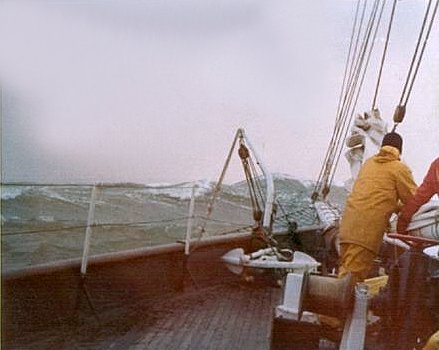|
By Chet J. Reitze As the crew can recall, North Sea tides are more extreme than most other areas in the world. In Dover, the ships had a dilemma as I remember. Both were moored in a small locked area, which maintained a steady depth free from the cyclical tides that affected the harbor. The tides had been running high during our time in Dover, but were on the decline. The lock doors were not water tight, and could only maintain a depth during the daily tidal low, even then, we lost 2 to 6 feet each day at the low and Te Vega's keel would hit bottom, giving her an odd list to either port or starboard. Te Quest had a lesser draft and was not effected. The dilemma was that the tides were cycling low, and if we did not leave soon, Te Vega would not be able to get out of the locks for at least 2 weeks. But the weather had been bad, and there were a number of times we prepared to leave, but our departure was called off due to dangerous conditions. I do not recall the date, but the weather had subsided a bit. Deck stations were sounded at about 6 AM, it was still not fully day, and the crew was instructed to prepare the ships for departure. I was on fender crew, so I recall Jim sitting in the radio shack pulling meteorological faxes and listening to Dover Harbor Radio's weather conditions. He was obviously making a difficult decision because the Channel that day, as with previous days, was running higher than the Dover breakwater, which was at least 10 to 20 feet high. It was an unusual sight, the harbor was relatively calm, but the sea outside was a wind whipped cauldron of high running white wave ready to transform any stable platform in to a washing machine. Even the hover crafts and ferries pitched and yawed as they navigated into port. Jim had the window as I recall, he had to go that day at that moment, or we'd be locked for at least a week or two with dangerously low tides, which would put the keels on the bottom causing a precarious list. I believe we were rafted, and our rigging would become entangled had we stayed. The atmosphere on board was one of anxious waiting, each one of us knowing that all hell was about to break loose. Jim finally gave the word, and the engine room crews were at the ready. Te Vega's Merleese was started and our lines cast-off. TeQuest followed suit. The brisk wind was blowing hard, and one had to speak loudly just to be heard. The dank smell of #2 diesel at last signaled our sure departure. Te Vega took lead through the narrow lock, as a work crew on shore watched us pass through. The men saluted and stuck out their thumbs as if hitchhiking. We motored toward the breakwater, with teQuest in pursuit. As we motored through Dover Harbor, the orders for how we were going to trim came forward. In our case on Te Vega, we were to put up our forestaysail and foresail for stabilization just prior to clearing the breakwater. I believe all crew members not raising the sails were asked to clear the deck to reduce the chances of anyone getting washed over the side. I was on the port foresail gaff-vang. This time as we prepared to raise the sail, no one rode the gaff up the mast, which was the standard method in better conditions. As we neared the breakwater, one could see the Channel running high above the breakwater, it was clear it was going to be sudden chaos once our bow hit that first breaking wave. Everyone was at the ready when Jim gave the word, and the winch crew started the foresail gaff up the foremast. The forestaysail went up quickly. TeVega's pitch into the swell increased in tempo and gravity as we neared the harbor's exit. I remember being flooded with adrenaline as I looked into what we were about to enter, it was a churning, boiling mass of wave, which was powered by high winds and tide. There was no logic, it was simply a 20 to 30 foot chop. The decks were suddenly awash, and the hull of TeVega shuddered with the forceful impact of the waves. It was hard to keep footing because a pitch would be matched with a violent yaw, and a roll with an unanticipated pitch. All I remember hearing was wind, winches and yelling. Water on deck was high, at least to my knees. I believe some of us lost our footing in the wash, but no one went over the side.
Once the sails were trimmed, and Jim made the course for St. Malo, we had a running sea. Although the waves were running high, as was the wind, the situation was quite stable. But it was cold, and I do recall it snowing. In fact, the lines wet with sea water froze in coils. Although I cannot be sure, I would estimate the waves out of Dover were in the 20 to 30 foot range, and the wind was blowing a force 6 to 8. It was definitely the highlight of my years on board (76-78). The only other event coming close to this was teQuest's broken bow sprit crossing the Atlantic. From the safe haven of TeVega, I remember her three masts swinging like match sticks as her triadics slacked, then became taught as she dove forward into a gale driven swell - the only longitudinal support being her backstays. But teQuest's crew did a remarkable job of regaining forward support by using lines, rolling-hitches and come-alongs, which I believe anchored her forestays to bow cleats. But Spring, Tono, Ann and teQuest's crew knows that story far better than I. |
